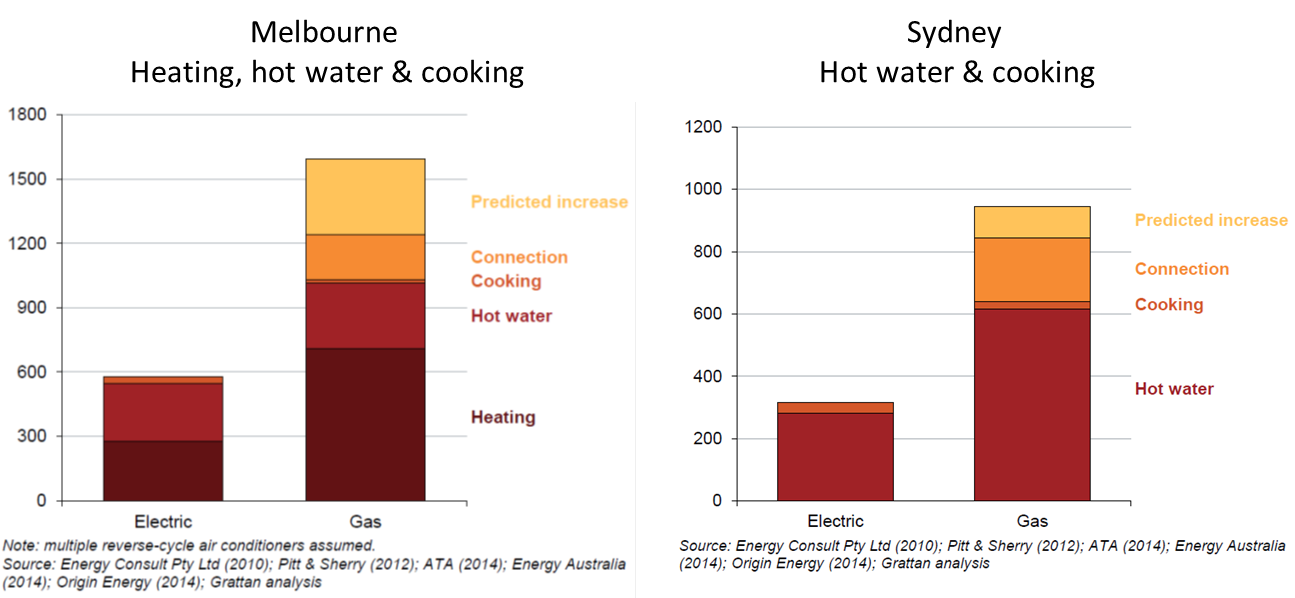The demise of gas in one chart
The Grattan Institute has released analysis looking at the likely consequences of east-coast gas prices rising as a result of the establishment of liquefied natural gas export facilities. For those who use a lot of gas and who both distribute and retail gas (as opposed to those extracting it out of the ground), the consequences are not pretty. But it could be good news for the electricity sector.
Over the last few years there has been considerable focus on how electricity prices skyrocketed since 2007, as a result of lax regulations introduced at the time for managing electricity network expenditure.
But what many have missed is that gas pipeline distributors also managed to convince regulators that they needed to expand their asset base to service residential and business customers as well. It wasn't anywhere near as bad as what occurred with power lines, but gas users now find themselves having to pay for extra pipeline assets. In addition, the Victorian Government continues to pursue a long-running program of subsidising the rollout of the natural gas network, which has cost hundreds of millions of taxpayers dollars over the years.
Yet will we need these extra pipeline assets?
What many people fail to realise is that the advent of highly efficient, low cost reverse-cycle air conditioners (also known as heat pumps) has fundamentally altered the economics of whether it makes sense to use gas for heating your home. These are now widespread across many Australian homes creating an already-deployed competitor to natural gas.
The next battleground will be water heating, and heat pumps are threatening to do the same thing in this application as they have in home heating.
The chart below taken from the Grattan Institute's latest report, Gas at the Crossroads, illustrates that households – particularly in Melbourne – will see notable increases in their gas bills as a result of the LNG-induced price rises. Even without these price rises households could achieve significant annual bill savings by shifting heating, hot water and cooking to electrical appliances. But the jolt of LNG-related price rises could be the critical prompt to consider disconnecting gas to achieve $600 to $1000 in annual bill savings.
Figure: Grattan Institute estimates of household bill savings from substituting gas with electrical appliances

The key prize for householders will be to remove the connection charge illustrated in orange in the chart above. This will require getting rid of gas heating, hot water and minor use in cooking.
For householders in Sydney (and also Adelaide, Brisbane and Perth) many don't use gas for heating the home anyway, so that leaves just hot water as a significant user of gas.
For Melbournians the extra capital cost to substitute electricity for gas in home heating could be negligible because often the reverse-cycle air conditioner is already installed with the intention of cooling use. Now sometimes this will just cover the main living room whereas gas heats the entire home. But an additional air conditioner or two installed in the appropriate location could address this at a cost between $1000 to $2500.
In terms of hot water you're roughly looking at a $2000 premium to shift to an energy-efficient heat pump over a replacement gas water-heater, and there is no premium for electric cooking over gas unless you really want super-efficient induction cooktops.
All up, households will be looking at a cost of around $2000 in Sydney to save themselves $600 per annum – a payback of three and a bit years. In Melbourne it's a premium of $3000-$5500 to save $1000 per annum for a 3-5½ year payback.
What is likely to have the gas distributors really scared is once households shift home heating over to reverse-cycle air conditioners then they have less gas volumes to recover the fixed costs of their pipelines. This will require upping charges which will make replacing the hot water system look even more attractive to householders, particularly in Victoria.
No wonder the gas pipeline owners' industry association, the Energy Networks Association, which also represents electricity networks, launched a concerted attack on the small-scale Renewable Energy Target a few weeks ago. Electricity networks are already concerned about how this scheme is supporting the rollout of solar electricity generating units (solar PV) which are leading to declining volumes of electricity over power networks. And gas pipeline owners also feel deeply threatened by the scheme because of its support for heat pump and solar water-heating units.
Gas pipeline owners conveniently forget how government has played a very strong role in supporting and subsidising the creation of residential demand for gas. Now they've established their own market, they're not happy at all about a government program doing the same thing for competing energy-efficient water heating products.
In the end the gas distribution companies (in conjunction with Victorian governments, both Labor and Liberal) have been a little too eager to expand their businesses and their revenue. Now that they face some stiff competition and customers who'll be highly sensitive to impending LNG-linked price rises, this expansion is looking extremely unwise.
















